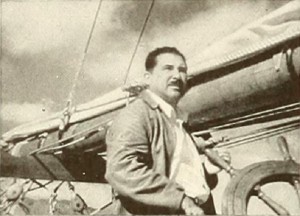
"Produced by the Long Beach (Calif.) Cinema Club for its local Community Chest, Because of You is a competent presentation of the various community services offered by the local welfare organizations which receive their support from the Chest. The activities of these agencies, as they aid an unfortunate family to which things seem to happen, are presented in a well-paced manner, without appearing to overemphasize any one agency over the others. The production was well photographed by Lucille Lloyd, capably directed and acted, and is smoothly edited. The narrative, while good, could have been shortened in spots. For a club and community effort, Because of You accomplishes its objective of making its viewers Community Chest conscious." Movie Makers, Dec. 1953, 334.

"Shows an expedition up Mount Grenville at the head of Bute Inlet" British Columbia Archives.
This film was produced in the late 1930s.
Beep Beep is a quickie little cutie that deals with the concern of a proud Cadillac owner when, at 120 miles an hour, a little Nash Rambler begins to go around him. If you recall the popular song by the same name, you know the outcome" PSA Journal, Sept. 1966, 35.

"When the schooner yacht Enchantress put out from San Pedro for a five weeks' marlin fishing cruise in the Gulf of Lower California, fortunately James H. McCarthy was on board with camera, Kodachrome and a filming plan. The result was Before the Wind, as happy a movie yarn of a pleasure cruise as we have ever seen. A spirit of jollity and a general good time pervade this chronicle, which is adequately strung on the thread of a series of entries in the ship's log of the Enchantress. This casual continuity is entirely sufficient, for each episode is beautifully sequenced, and the whole film reflects a consistent happy go lucky holiday spirit. Exquisite shots of the schooner in translucent California Gulf waters, numerous studies of ship life, handsomely lighted interior views in cabins and engine room are all technical accomplishments in this picture. The sequences of marlin fishing and of clam digging on the Mexican shore are gems of good film planning and good cutting. The movie is presented with an intelligently planned musical accompaniment that really fits the film, but it is the natural handling of sequences of people on a carefree sea vacation that makes this picture superb entertainment." Movie Makers, Dec. 1940, 577.

After celebrating his fourth wedding anniversary, a man becomes obsessed with building a homemade weapon of mass destruction. The man's efforts reach a breakthrough after the couple celebrates their fifth anniversary.

"Produced several years before the historic Stonewall uprising for LGBT rights in 1969, director Nikolai Ursin's gently-activist short Behind Every Good Man (c. 1967) provides an illuminating glimpse into the life of an African-American trans woman. In strong contrast to the stereotypically negative and hostile depictions of transgender persons as seen through the lens of Hollywood at the time, the subject of Ursin's independent film is rendered as stable, hopeful and well-adjusted. The resulting intimate portrait serves as a rare cultural artifact of transgender life and African-American life in the U.S. at the mid-century," UCLA Film & Television Archive.

"Amateur filmmaker H.A.V. Bulleid spins a web of intrigue in a feature-length tale that pits British secret servicemen against Russian agents desperate to obtain a top secret document. When Agent Malloon (Michael Kitchin) is given the task of protecting top-secret plans of utmost international importance, Jim Weston (Stephen Bostock) and Vernon Stone (Sinclair Loutit) - Malloon's closest friends - are busy competing for the affections of his sister, Jill (Carrie Hopkinson). Seemingly a hapless idiot, Weston is in fact a secret service detective, acting the fool in order to dupe Stone, a Russian super-spy. And when Stone and his Russian associates beat Malloon unconscious and steal the documents, it is up to Weston to lead the charge as car chases and deadly fist fights ensue. But can Jim Weston retrieve the papers, save the nation and - most importantly - finally conquer Jill Malloon's heart?" (EAFA Database).

"Paul Thompson's Behind the Bale would be an amazing performance for a large studio, equipped with many facilities and numerous staff members, and this is true by reason of the exceedingly careful collaboration between the film editor and the comment writer. For a small producer of industrial pictures, Behind the Bale is a triumph in the technique of post recording, as well as a beautifully made picture that would stand on its own feet without narration and with relatively few titles. A Northwest brewer wishes to make it clear that the quality of hops has much to do with the quality of beer. Therefore, Mr. Thompson shows us the Yakima (Wash.) Valley briefly and then gets down to the special crop which the film pictures. We follow hops through planting, growing, picking and baling, in a Kodachromatic exposition that has rare beauty, and we end with four men enjoying the beer of Mr. Thompson's client. In the entire course of this fine piece of cinematography, there is a wizardry of cutting the film to fit the narration — and the reverse — that produces exposition timed with scene in a fashion that would do credit to the best industrial filmers anywhere." Movie Makers, Dec. 1941, 564.
Total Pages: 299